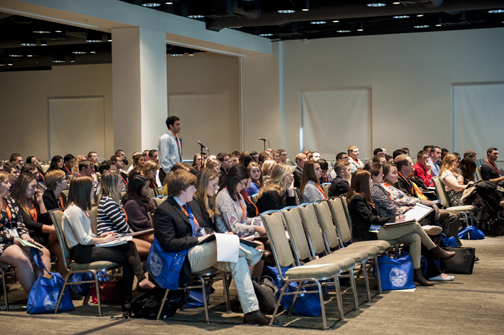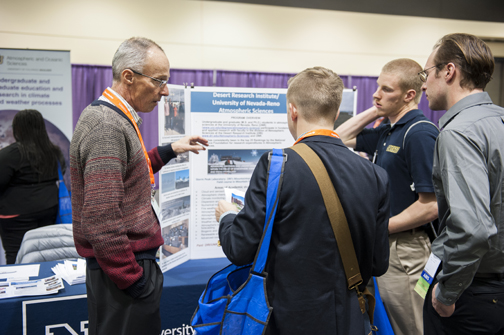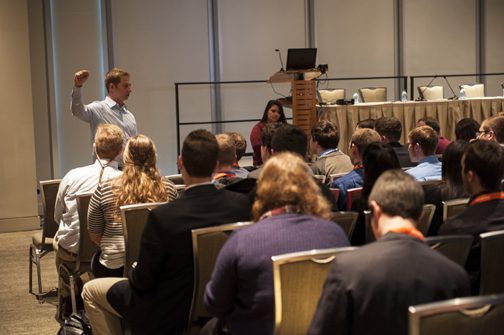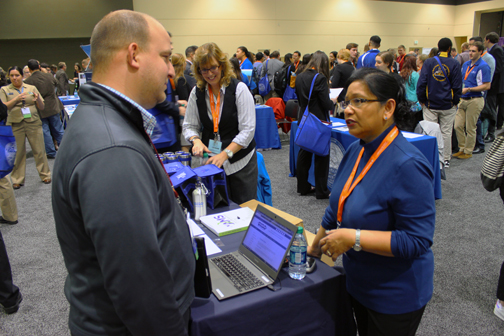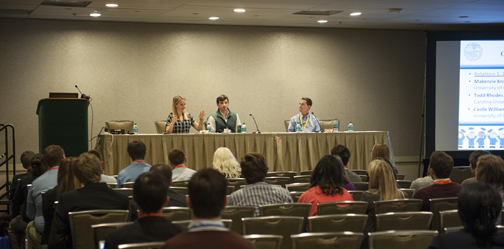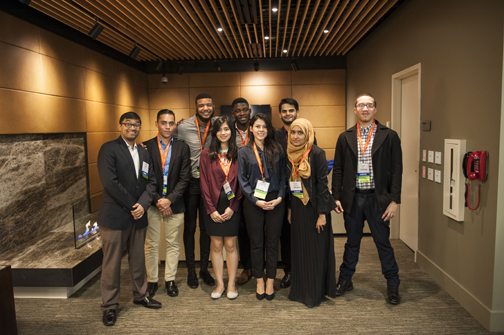There were plenty of entertaining and educational observations made by weather enthusiasts of all ages at WeatherFest on Sunday. Close to 2,00o people visited the Convention Center for an afternoon of weather experiments, exhibits, and festivity. There was even a special appearance by Owllie Skywarn!
Check out a few of the highlights here:
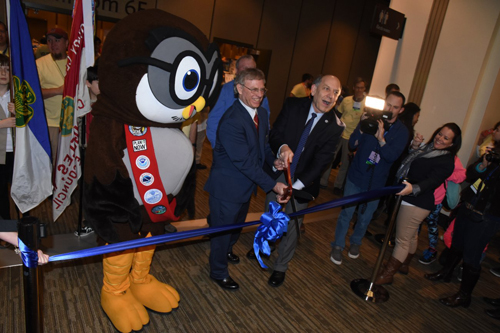
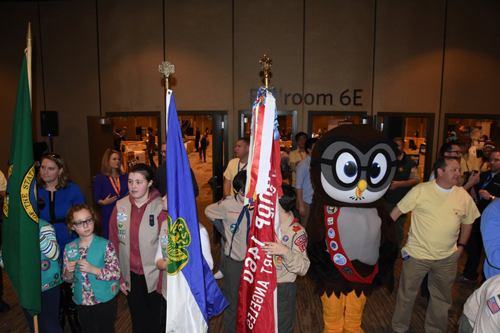
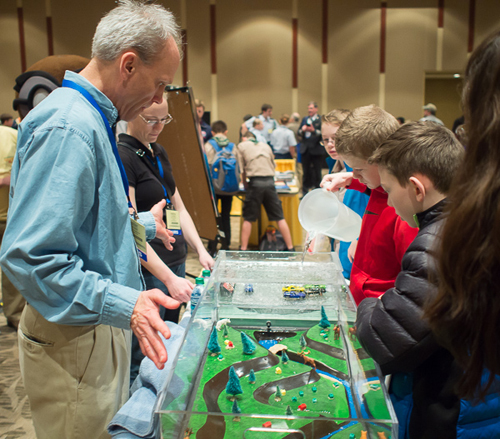
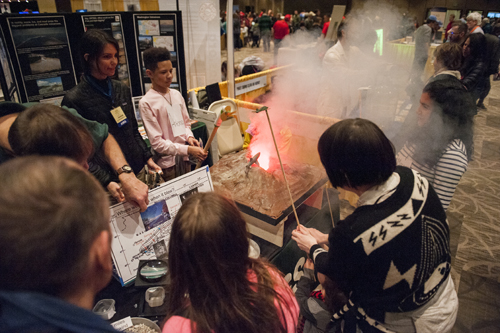
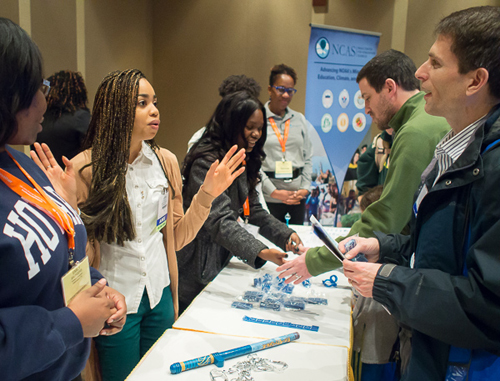
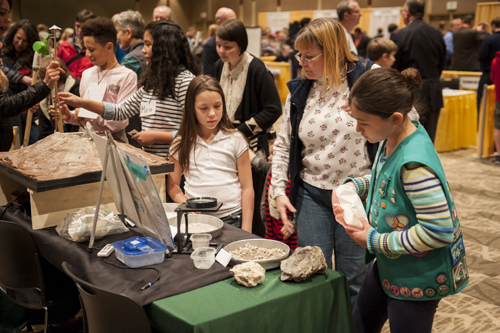
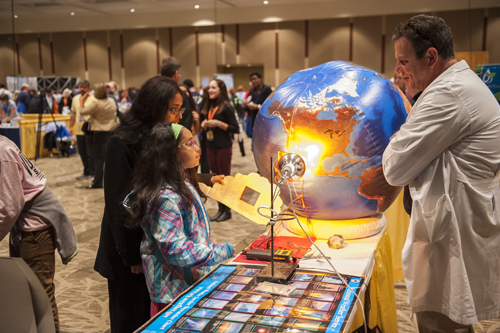
 Matt
Matt
Don't Stay Neutral
by Keith Seitter, AMS Executive Director
Back in September, I had the privilege of taking part in an excellent workshop on sexual harassment in the sciences that was convened by AGU in collaboration with several other societies. Several sessions of the workshop included discussion on how to reduce the potential for harassment at scientific meetings, so with the 97th AMS Annual Meeting just around the corner, I want to take this opportunity to address these issues.
First, it is important to recognize that sexual harassment in the sciences is more prevalent than most of us would like to believe. We have all read about some of the high-profile cases of truly egregious misconduct between senior scientists and students or junior colleagues. Much, much more common are types of harassment that may fall well below the legal standard for prosecution but are, nonetheless, unacceptable levels of behavior in a professional setting. As the workshop highlighted, these forms of harassment are able to exist partly because many of us are reluctant to take action when we see them (or even when we experience them)—choosing instead to “remain neutral” and not call someone out on behavior that has made someone else uncomfortable.
AMS has an excellent statement of “Professional and Respectful Conduct at AMS Meetings” that can be found here. This statement makes it clear that AMS expects all attendees to adhere to levels of professional behavior that ensure attendees will feel safe and comfortable throughout the meeting and all associated activities. It includes actions AMS will take if attendees do not adhere to these guidelines. As noted in the conduct statement, AMS has established several mechanisms for reporting unprofessional behavior at a meeting (which include sending an e-mail to [email protected], leaving a message on a special hotline at 617-226-3965 that will automatically alert a response team of senior AMS staff members, or simply letting anyone with a staff badge know about the issue).
The most powerful and effective mechanism to ensure a climate of safety and comfort at meetings, however, is for all of us to do our part and not stay neutral if we see or experience behavior that is not consistent with professional and respectful conduct. Take a few minutes now to imagine a scenario in which you see something that makes you or someone else uncomfortable, and think of some phrases that you could be comfortable saying. It can be simple, along the lines of “It is not OK to talk that way” or “that is not the way we do things.” A few simple words can have an enormous and immediate impact. The important thing is that you say something. Doing so will promote a climate of respect and help ensure that the kind of behavior we all expect at a scientific meeting is, in fact, what we experience.
(A version of this post appeared in AMS Executive Director Keith Seitter’s “Letter from Headquarters” column in the November 2016 BAMS.)
Policy Before and After the Presidential Transition
By Paul Higgins, AMS Policy Program Director
Presidential transitions are a time of uncertainty, change, and opportunity. For the AMS Policy Program, and for the entire AMS community, the transition from President Obama to President Trump offers a chance to reflect on our role in the broader society and to reevaluate how we might engage that broader society most constructively.
Our role is to advance science. For us, that means increasing both the potential for scientific discovery (i.e., through research and observations) and for the beneficial use of scientific understanding by the broader society (i.e., through the application of science and informed societal decision-making).
The AMS Policy Program uses three primary approaches to advance science: 1) we develop capacity within the scientific community for effective and constructive engagement with the broader society, 2) we inform policymakers directly of established scientific understanding and the latest policy-relevant research, and 3) we help expand the knowledge base needed for incorporating scientific understanding into the policy process through research, analysis, and studies.
Since the election, AMS Executive Director Keith Seitter and I have been active in reaching out to Congress and the transition teams. We’ve had discussions with staffers from both parties, including those who serve on the Senate Commerce and Appropriations Committees and the House Budget, Science, and Appropriation Committees. The meetings gave us the chance to distribute the AMS priorities statement and to provide background information on Earth observations, science, and services. The discussions have been going very well and they’ve helped to reinforce the value of our information-based, nonpartisan approach to policy engagement. Staff from both sides of the aisle express their appreciation for our approach and their high regard for our input.
Over the next several months, we will continue to consider ways that we can build on our core approaches to advance science most effectively. Our activities will almost certainly emphasize six basic strategies:
- To develop, communicate, and advance a positive vision for Earth observations, science, and services (OSS)
- To engage constructively with administration officials, the agencies, and congressional staff from both parties to encourage scientific advancement
- To praise, thank, and congratulate those who make positive contributions to Earth observations, science, and services
- To identify, characterize, and work to resolve efforts that may be counterproductive to scientific advancement
- To empower the scientific community to engage effectively and constructively with the policy process
- To improve our communication with (and outreach to) AMS members, other scientists, policymakers, members of the media, and the public with respect to the advancement of Earth observations, science, and services.
For now, we are focused on opportunities to work with Congress and the new administration to advance science and its beneficial use. We strongly believe the most effective approach to policy engagement starts with first building solid relationships, particularly with those with whom we differ. Building relationships depends on respect and understanding—recognizing that those who see it differently can still be high-minded people who are working toward their vision of a stronger country and a better world. In my experience, the vast majority of policymakers in Washington, D.C., have good intentions.
We understand why many are concerned about the potential for the misuse or abuse of science. We hope the need to protect scientists and science (e.g., from attacks or from misrepresentation and misuse) will not be necessary, but AMS has been strong on that in the past and is prepared for it again whenever necessary.
Now is an important time to engage constructively with the policy process. We can advance science most effectively with strong positive messages about the role of science in society. After all, our science helps efforts to meet basic human needs including food, shelter, energy, health, and safety. We need not be shy in seeking strong positive outcomes for our community or for the broader society that we serve. The policy process is complex, however, often more so than outsiders (including scientists) recognize. When we can balance humility about what we don’t understand about the policy process with confidence in what our science can provide to society, our efforts to engage will be more well received and that will lead to better outcomes.
Policy choices have the greatest chance to benefit society when grounded in the best available knowledge and understanding. Through our activities, the AMS Policy Program advances societal decision-making with respect to weather, water, and climate. This helps policymakers recognize and manage Earth system risks, and take advantage of emerging opportunities our science makes possible.
AMS Community Priorities for the New Administration
By Fred Carr, AMS President
Now that the election is over, a furious amount of activity has ensued on who will be in the new administration and what policies they will pursue. AMS members are particularly concerned about future science funding levels, environmental policies, observational and research infrastructure, STEM education, and who the new leaders will be in agencies that oversee aspects of the weather, water, and climate (WWC) enterprise. To provide guidance to those involved in the transition period, the AMS created a policy statement titled “Weather, Water, and Climate Priorities” that is located here.
I would like to summarize a few vital aspects of this document here. The fundamental premise is that “Economic and social prosperity belong to a society that understands and effectively responds to Earth’s changing weather, water, and climate conditions.” There is no doubt that many changes are occurring in the Earth’s physical and biological ecosystems (atmospheric and oceanic warming, Arctic and glacial ice losses, sea level rise, land use, drought and flooding intensities, etc.), most of them resulting from human activities. They are affecting our quality of life and large portions of our economy, and will worsen with time. These changes cannot be ignored, and national investment and leadership are needed.
The AMS policy statement provides recommendations on how to address these challenges, which require holistic, bipartisan, and coordinated strategies to accomplish. Some of them are:
- The nation must invest in educating the next generation of scientists.
- Both basic and applied research in the geophysical and environmental sciences must increase.
- Observational infrastructure should increase across the WWC enterprise.
- The U.S. should lead the world in high-performance computing.
- Effective outreach to the public and decision-makers is needed to develop a scientifically literate citizenry and data-driven, science-based policies.
- Partnerships among the academic, public, and private sectors are needed to develop successful policies and actions.
- Outstanding individuals are needed to provide effective leadership of WWC-related agencies, advisory groups, and industries; they must be well-qualified, visionary, and diverse.
These recommendations make sense across the political spectrum, and I encourage readers to do what they can to bring them to the attention of the new administration.
GOES-R: Are You Ready for Something Awesome?
By Jonathan Malay, AMS Past-president and retired Lockheed Martin Washington Operations
I’m sorry to say, the word “awesome” seems way overused these days. OK, it’s pretty funny when Cecily Strong’s character on Saturday Night Live’s “Girl Talk” sketch keeps saying “Awesome!” That’s amusing, but it’s not awesome. Awesome is a word we simply can’t help ourselves from using when we’re really blown away by something, like when we gaze at the natural miracle of the Grand Canyon below us, or when we behold the immensity, both in size and raw emotional impact, of the new One Trade Center in southern Manhattan, or when we see an Olympic record being broken.
As a meteorologist and a space guy, I’ve been fortunate enough to look up at the Space Shuttle from the foot of its launch pad at Cape Canaveral. I’ve seen the brilliant flames when the mission lifted off, and, a few seconds later, felt the vibrations of sound waves penetrate all the way to my bones. I stood in a clean room at the Stennis Space Center a few years ago where I saw, and actually touched, the initial structure and propulsion module of GOES-R, a spacecraft destined to become the first of a new and revolutionary generation of geostationary meteorological satellites. I can honestly say these things I saw and felt were really and truly awesome. 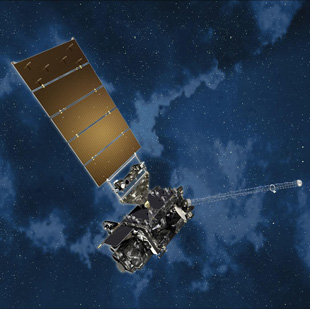
If the schedule holds, at 5:42 p.m. this Saturday, November 19, that satellite will be launched. Thousands of eyes, either in spectator locations, or in mission control rooms, at National Weather Service centers, on big-screen TVs, on computer monitors, or even on handheld devices, will watch the magnificent white- and copper-colored Atlas V as its powerful RD-180 engines ignite and send the GOES-R spacecraft toward its assigned orbit in space. It will be awesome. Really and truly.
GOES-R, which has been some 15 years in the making, is going to deliver to meteorologists, oceanographers, and space weather forecasters at NOAA and everywhere—and to the people of the United States and all the Americas—a truly awesome set of capabilities, such as:
- Three times more spectral information
- Four times greater spatial resolution
- Five times faster coverage
- Real-time mapping of total lightning activity
- Increased thunderstorm and tornado-warning lead time
- Improved hurricane track and intensity forecasts
- Improved monitoring of solar x-ray flux
- Improved monitoring of solar flares and coronal mass ejections
- Improved geomagnetic storm forecasting
By now, AMS members and the meteorological community are probably aware of the improvements GOES-R and the other birds in the series—S, T, and U—will provide over the current GOES-N/O/P-series satellites, which have been in orbit since 2006. This new generation of GOES satellites will far exceed anything we’ve seen before. As someone who lived the GOES-R experience while working at Lockheed Martin in Washington, D.C., I’ve had the privilege of knowing and working with many of the fantastic people who have made it a reality. These folks at NOAA and NASA, on the White House staff, on Capitol Hill, at my great company, at our industry partners, and across the meteorological, oceanographic, and space weather communities . . . there are too many of you to acknowledge individually (except program director Greg Mandt, my good friend and colleague, who truly deserves a special shout-out)—you have all been awesome!
So, along with all my friends in government and at Lockheed Martin Space Systems and the Advanced Technology Center, United Launch Alliance, Harris, Exelis, ATC, LASP, and all the great contractors on the team, we’ll all be watching Saturday’s rocket launch, saying with all our hearts: “GO GOES-R! GO ATLAS!” And then, as the mission disappears in the sky, we’ll all involuntarily say, “Awesome!”
Looking Back on a Consulting Career
By William Haggard, CCM
(This post is adapted from the Introduction to the author’s new AMS book, Weather in the Courtroom: Memoirs from a Career in Meteorology. You can purchase the book from the AMS Bookstore here.)
I have been very fortunate to have had many wonderful experiences, and to have known at age 4 that I wanted to be a weather man. Being a forensic meteorologist was exciting, challenging and filled with the fun of meteorological detective work. The purpose of writing my new book, Weather in the Courtroom, was to share some of the significant cases in which I played a part. One goal was to choose interesting cases, and another was to show the variety of weather situations that can affect litigation. 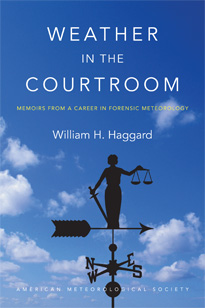
While serving as the director of National Climatic Data Center (NCDC) between 1963 and 1975, I had been impressed by the large number of attorneys requesting weather data for litigation cases. The center would offer data certified by the Department of Commerce but government meteorologists could not be released from their duties to interpret this data in the courtroom. This void was filled by consulting meteorologists.
I decided that after retirement from the federal government I would become a consulting meteorologist specializing in forensic work. This specialty would allow me to bring weather testimony into the courtroom. In 1976, I formed the Climatological Consulting Corporation (CCC) and sent letters of introduction to lawyers listed in legal directories who appeared likely to need weather testimony in their litigation. They included aviation, marine, and insurance lawyers.
The first response came several months later from Charles Hagan in Anchorage, Alaska, who needed an expert weather witness in a plane crash. Though the weather analysis was complex, I was faced with the great challenge of learning courtroom procedures and the behavioral techniques that would convince the jury that I was a credible witness. I learned the importance of effective visuals with the concept that people retain 80% of visual information versus 20% audible.
When I started in this field, there might have been up to 50 other forensic meteorologists. Few were using visuals to show the details of their analysis and to illustrate the weather to the courtroom. I quickly learned the importance of these images and spent a lot of time trying to improve them. I greatly appreciated the help of my wife, Martina, an accomplished artist, who designed and perfected many of them. We started with hand drawn poster boards and evolved to large, commercially produced color images.
From there, I graduated to carrying an overhead Vugraph projector and screen to display transparencies to the court. I became known as the man with the pictures. My expensive analysis projector in the 1980s, which could project a time-lapse sequence of images, was a great improvement in showing sequential radar images. First used in a case of a ruptured oil tank in Hurricane Alicia, the jury was convinced of my testimony after seeing the rainbands moving over the stationary image of the tank on the screen. With time and technology, televisions were installed in courtrooms, strategically placed before the jury, judge, and council. Computers and computer simulations have now taken over.
After a slow start, word of mouth advertising, attending various lawyer conferences, and hard work all helped increase my business. Meeting and working with so many talented attorneys and staff was a great experience. My staff increased, my travel increased, and my lifelong passion of working with the weather continued. We worked on hundreds of cases varying from simple “slip and falls” to complex weather patterns such as those found in the Perfect Storm of 1991.
I had taken the challenging test and been the 150th to obtain my CCM from the AMS. As the caseload increased, I realized the need for more specialized interpretation of satellite data, hydrology, radar, and severe weather. I began affiliating with other CCMs in these subspecialties to better meet the client’s needs. These associates greatly assisted me in their specialty and enhanced the final work product.
I grew up sailing, served in the navy, and was an oceanic weather forecaster. I had expected marine meteorology to be the cornerstone of my courtroom work, but aviation became predominant until late in my consulting experience. The aviation attorneys that engaged me became frequent clients and spread the word. Approximately 75% of my over 200 cases involved aviation weather. The data required are somewhat different for aviation and marine cases, but were all are available from the National Climatic Data Center.
With these data I began my detective work. Forensic meteorology requires careful and accurate retrospective weather reconstructions. These often required very detailed and small time/space scale analyses—frequently relying on supplemental and/or non-standard meteorological data such as eyewitness statements, photos, police reports, NTSB reports, site visits. The great improvements in meteorological technology, in the resolution of meteorological images, and in the availability of the data all helped in my analyses of the weather.
After I moved to Asheville in 1961, my wife and I had purchased a hilly 100-acre farm east of Asheville. In 1975, we built our dream house there and I started my new company in the den with one secretary and a graphic studio area in the large basement. As the staff grew in size, we moved to a remodeled house near the creek. This location, overlooking large pastures, was a beautiful setting for the next 20 years. When I became frustrated by a technical problem, I would announce to the staff, “I’m going out to mow,” and would climb on my riding mower. Nature’s panorama of blue skies, white clouds, hillside forests and green grass helped clear my mind and was conducive to constructive thinking allowing me to return to the office with a fresh view and a mowed pasture. The five-minute walk from home to the office made it very convenient for me when I was not travelling. And I did travel extensively to meet clients, visit accident sites, testify in court attend depositions and meetings. I became a 1.6 million miler with Delta Airlines.
Writing this book has brought back fond memories of these great 26 years. I hope you enjoy it.
Your AMS Membership Has Never Been More Valuable
by Keith Seitter, CCM, AMS Executive Director
(From Dr. Seitter’s column in the June 2016 Bulletin of the American Meteorological Society.)
There are a variety of ways to think about the word “value” and to apply that term in the context of being an AMS member. Those who consider the value of membership in terms of financial benefit are likely to recognize that their subscriptions to BAMS and Physics Today, as well as any of several types of member discounts (such as that for meeting registration) can easily offset the cost of dues.
While fully appreciating the importance of member discounts on AMS journals, Weatherwise magazine, books, merchandise, meetings, and other services, I have always tended to think of the value of membership in terms of the less tangible aspects—and this has been true for me reaching back far before I was part of the AMS staff. My AMS membership makes me part of a vibrant community of scientists and professionals with common goals. I have always taken great pride in being associated with an organization that promotes the advancement of knowledge and understanding about our environment, that stands up for the integrity of science, and that helps ensure that the scientific understanding coming from the research community is translated into effective actions that protect lives and property.
In addition, my involvement with AMS—especially early in my career—opened up avenues for professional growth that helped shape my career in important ways. Volunteer service with AMS drew me deeper into the community and introduced me to colleagues who have become lifelong friends. AMS meetings further expanded opportunities for networking and collaboration, which allowed my work to be more productive and successful. Many of the most important turning points in my career can be traced back to my membership with AMS.
I was talking with a longtime member a few months ago about why he enjoys his volunteer service with AMS so much. His words struck me as clear and on target. He said, “The Society is not here to give you things. The Society is here to help you get the most out of your professional career.” I think there are thousands of us in AMS who would agree with this, and who have experienced firsthand the value of being part of an organization that represents a truly incredible community of scientists and other professionals dedicated to serving society. The impact of the science and services provided by the AMS community has never been greater, and the continually expanding role of AMS in serving and representing this community means your AMS membership has never been more valuable.
With new services coming online, we think the tangible benefits of being an AMS member have never been more significant, while the intangible value—the many ways that AMS promotes community and collaboration—also continues to strengthen and grow. If you have colleagues who are not AMS members, but should be, I hope you will encourage them to join AMS and become part of this truly unique community.
2015: The Hottest Hiatus
It was predicted early and often—and now, finally, it’s official. Throughout 2015, climate-watchers at NOAA and NASA were giving indications that the world’s surface temperature was going to top every annual mean measured since records began in 1880. Today, the two agencies with independent analyses jointly confirmed that global surface temperatures in 2015 blew away the record set in 2014.
The mean global temperature in the analysis by NASA’s Goddard Institute for Space Studies was 0.13°C above the 2014 record, and NOAA’s National Centers for Environmental Information had it as 0.16°C above. In all, according to NCEI, 2015 was 0.90°C above the 20th-century average.
The temperature record was no surprise, even though 2015 set a new record by the largest margin ever recorded. In the horse race of annual temperatures, 2015 jumped out of the gate ahead of the pack and never looked back at previous record holders like 1997, 2005, and 2014 (see the NOAA graphic below). It was a wire-to-wire victory in which 10 of 12 months were the hottest ever on record for their respective periods. Indeed, going into the homestretch, NCEI pointed out that December 2015 would have to stumble to more than 0.81°C below average to avoid setting a record. Instead, December extended the year’s lead by registering 1.11°C above the 1880-2015 century average—in other words, it was the hottest month in the century-plus of measurement history.
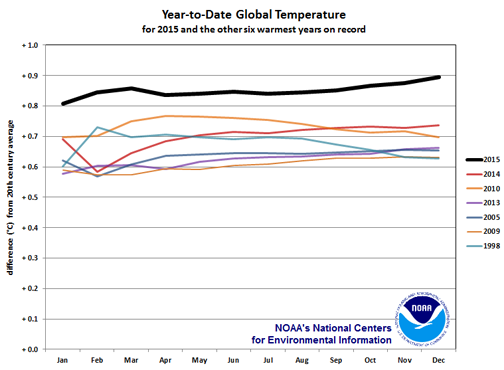
Inevitably, the question arises: does this record conflict with the notion of a “hiatus,” which the IPCC addressed in its Fifth Assessment Report in 2013? Trend aside, 15 of the 16 hottest years on record have occurred in this still-young 21st century, according to NASA; NOAA says four different years in that brief period have now reset the global surface temperature record.
Not surprisingly, a decade or so is a mere blip in climatology terms, and the short-term trend of global warming depends on where you mark the start and end point of your analysis. The warming has been relatively fast since 1970—about 0.16 or 0.17°C per decade, depending on your dataset. If you just look at only 1998-2012, as IPCC did, during sustained warmth near record levels, the upward trend is half what it is over the longer period. Of course, starting with 1998 means starting out very warm—hence a trend with major handicapping.
As a result, there’s been scientific backlash against use of the term “hiatus.” As Stephan Lewandowsky, James Risbey, and Naomi Oreskes point out in a newly released article in BAMS, the word doesn’t fit:
The meaning of the terms “pause” and “hiatus” implies that the normal fluctuations in warming rate have been surpassed such that warming has stopped.
They show that warming looks slower or faster depending on the start date of any given 15-year period, but that none of the slowest-warming periods, including the last 15 years, is any slower than one might expect in a warming climate post-1970 (or indeed less remarkable with longer periods one might choose). They conclude,
The “pause” is not unusual or extraordinary relative to other fluctuations and it does not stand out in any meaningful statistical sense.
Lewandowsky and colleagues go on to show that, objectively, “hiatus” doesn’t pass the eye test. When tested by looking at a curve resembling the global temperature curve, experts and nonexperts alike perceived a long-term, uninterrupted upward trend. The authors conclude that misuse of the word “hiatus” distorts how the data look, and thus impedes not only public perception of global warming but also scientific work.
One benefit of the “hiatus” talk is that scientists have been motivated to ask more questions about the normal short-term fluctuations of climate. One purpose of the Community Earth System Model’s Large Ensemble Project, for example, is to produce large numbers of climate model simulations to help “disentangle” model error from internal climate variability—that is, the fluctuations caused by climate irrespective of anthropogenic forcing.
In an article in the August issue of BAMS, the ensemble project’s investigators show a sample experiment in which the slower warming of the last 15 years has actually been a pace well within normal variability, with or without greenhouse gas forcing (see figure below).
As the world continues to warm, this year’s record is prone to fall. Meanwhile, the ensemble also shows that the odds of a 10- or 20-year fluctuation stopping the warming—let alone a brief cooling—keeps getting tinier and tinier.
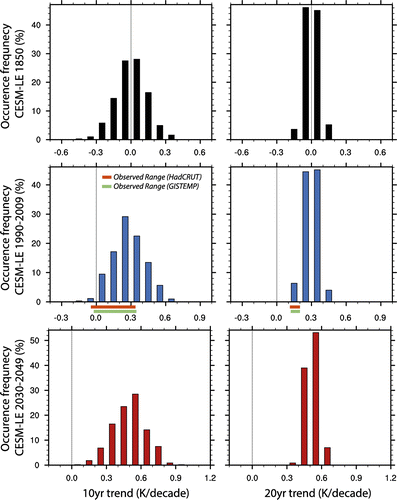
Be Diverse and Follow Opportunity
by Kyle Brown, Valparaiso University, AMS Communications Intern
You’re no longer likely to be “just” a forecaster, broadcaster, or researcher over the course of your career in this field. That mobility—or, as some might say, instability—of working in the water, weather, and climate field was a key point from Wednesday’s AMS Presidential Town Hall meeting.
The Town Hall provided insight into career opportunities and career changes within atmospheric sciences. Panelists included Heidi Centola, manager of business development at Schneider Electric; Michael Farrar, director of the Meteorological Development Lab of the NWS; and Kevin Petty, chief science officer at Vaisala.
They stressed that some career shifts result from opportunities that present themselves through the most unlikely of sources. Other shifts come from within–the panelists recommended that midcareer professionals perform a “gut-check” to ensure that they are happy and being challenged at their jobs.
With this in mind, the panelists considered the question, “What are the trends and opportunities ahead in meteorology?” Petty suggested individuals should pursue skills in data analytics. Farrar commented on the time constraints NWS forecasters face with the multitude of incoming weather data. Forecasters now have to efficiently digest data and add value in a short amount of time. This can be achieved through strong communication skills.
Centola reminded the audience that all industries are impacted by the weather. Therefore, she recommended finding a niche for the use of one’s meteorological skills, such as in insurance or transportation. Specialization is a process that may happen in the least likely of times or ways. In fact, the panelists attested that they have been surprised with their career paths. None of them had been able to anticipate that they would be doing what they are doing today.
As a result, the unpredictable migration of careers makes it essential to broaden one’s interests and skillsets, even while developing specializations. Professionals need to keep their doors open to whatever opportunities may be knocking. Centola told the audience that she started out selling flood insurance after college and then became a salesperson for WSI. Now she finds herself in the energy sector. Petty added that students should know other disciplines, and students were advised to broaden their coursework. Farrar said he would like to see more partnerships and linkages between atmospheric scientists and others within various industries, which could also help broaden exposure.
